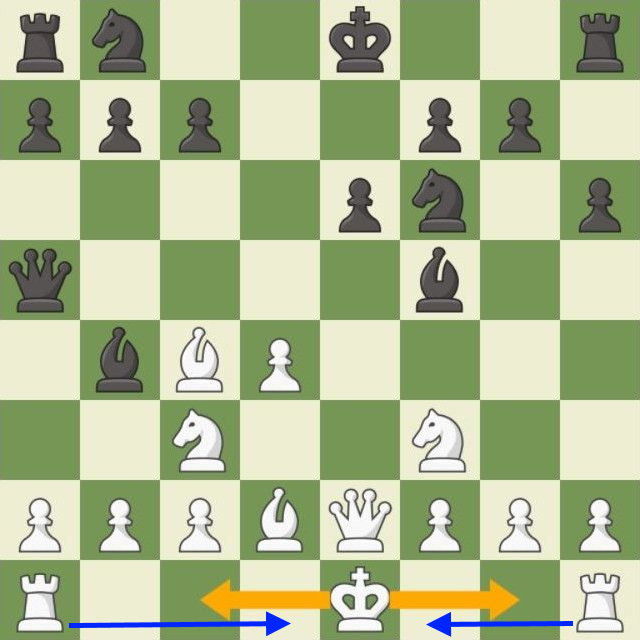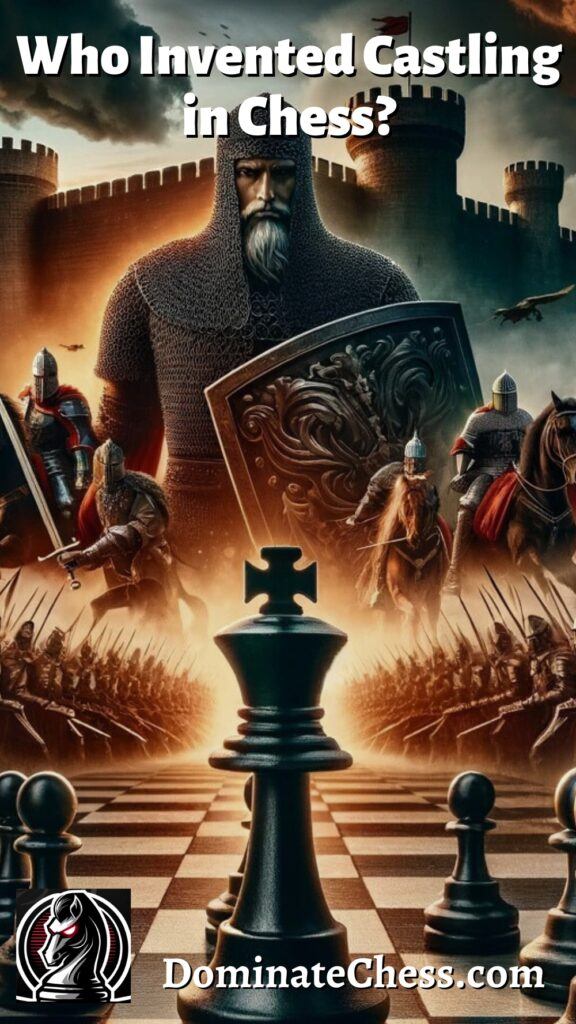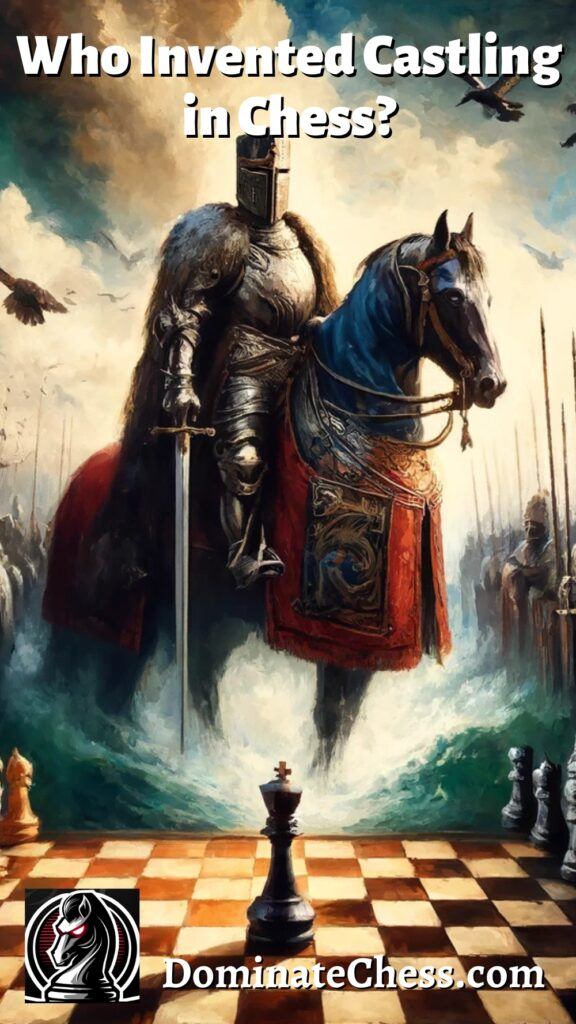One special move definitely stands out when it’s made on a chess board. Who invented castling in chess? How did this rule change come about? Or was it a rule from the beginning?
Who Invented Castling in Chess?
Castling in chess comes from “the King’s leap” rule used in Medieval chess where the king could move two squares on his first move to get out of early game traps.
If you’ve ever wondered about the origins of castling in chess you’re definitely not alone.
Between castling and en passant, there are really only 2 special moves that can be made on a chess board.
When I first learned chess, the castling move definitely stood out. It’s the only move where you can move two pieces at once AND the only move where a king can leap two spaces.
What is Castling? How Does It Work?
As you can see in the video above, castling is a special move where two pieces, your king and your rook, are moved at the same time.
Castling allows you to both protect your king and develop your rook all in once move.
The move itself consists of moving your king two squares toward a rook on the same rank and then moving the rook to the square that the king passed over.
Castling can be done to either side of the board, both “king’s side” and “queen’s side”.
There are a few very specific rules that have to be followed to allow for castling.
- You cannot castle when you are in check.
- You cannot castle if your king would castle “through” a check, or if after castling your king would land in check.
- You cannot castle if there are any pieces between your king and rook.
- You cannot castle if your king has made any other move before, or if the rook you are castling with has already moved
If you need a visual explanation of any of those rules for castling, the video above shows them in great detail.
Related Article at DominateChess.com!
Ever heard of sudden death chess? Check out “What is Sudden Death in Chess?”
Is Castling Accepted as a Rule Everywhere?
Although castling is widely accepted and played around the world, it is still not played in Asian versions of the game.
As unique as castling is, I honestly can’t even imagine playing the game without it. It’s one of the first goals most players have in the beginning of any game.
In fact, it’s driven me CRAZY before when an opponent uses a bishop or queen to block me from castling.
You can easily throw a wrench into your opponent’s game when you can stop them or at least delay them from castling when they want to.
Why Castling was Introduced as a Rule
In the opening moves of a chess game, players should be looking to get their pieces active on the board.
Pawns are moved out to occupy and control the center and make room so knights, bishops, and rooks can develop.
While developing your pieces you should also work to protect your king. Castling allows both development of your rook AND protection of the king in one move.
This definitely helps to speed up the game and get your key pieces into the action!
And as we dive into castling’s early origins, we find that helping the king get out of a jam was a big part of early castling.
What are the Early Origins of Castling?

In the earliest iterations of chess, rules were made to help get the king get out of traps. This was a response to rule changes that gave bishops and queens the long range mobility we know today.
The bishop originally could only jump two squares diagonally. While the queen could only move one square diagonally.
But around 1475, the “Mad Queen” variant came along and gave the bishop and queen much more importance with their long range moves.
Once this happened, it was found that you quickly trap a king quite early in the game.
To combat this, the “King’s Leap” rule was adopted.
The King’s Leap rule allowed the king once per game to make a two square jump to get out of traps. Some versions even allowed the king to jump to the second or third rank or leap over any piece in its way!
By the early 1600s the King’s Leap had evolved into the two modern castle moves we know today (king’s side castle, and queen’s side).
In my research I did find a bizarre story about a King called Richard the Corpulent who challenged anyone in his kingdom to a 4 game chess match.
In the story the king was close to being beaten, and thereby losing half his kingdom, so he invented castling right on the spot to gain the advantage.
I’m thinking that article was just a fictional story. But if you have any better guesses let me know in the comments below!
What is the Notation for Castling?
Chess notation is like the shorthand language of chess that describes the move for move game play.
It’s basically telling you exactly which squares pieces are moving to and if they’re doing anything important like taking a piece or placing a king in check.
I normally don’t take much interest in chess notation, but I couldn’t help but notice the notation for castling while addictively playing games on chess.com.
So normal chess notation while you’re playing a game looks something like this:
- d4 c5
- d5 e6
- c4 b5
- e4 Qa5+
- Bd2 b4, and so on…
But when castling happens it looks kind of cool.
Castling to the king’s side looks like this “0-0” in chess notation. While castling to the queen’s side looks like “0-0-0”
It really stands out!
(Yes, I know, “nerd alert.”)
Final Thoughts
Castling started off as the King’s Leap to help protect the king from early game traps and speed up the game and by the early 1600s had morphed into the rule we know today.
What do you think? Had you ever heard of the King’s Leap before? How early in the game do you make it a point to castle? Or do you prefer not to at all? Let me know how you feel in the comments section below! I love reading your questions and comments and I always reply back.
Like This Article? Pin It!




Hi Eric,
This is such an interesting article and it’s amazing how much knowledge you have on the game of chess.
The best thing about it is you are willing to share your knowledge and help up and coming chess players.
My nephew is an up and coming chess player and he would love to learn about castling.
So, I am going to share this article with him and then I will be the cool uncle.
Thank you for sharing and keep up the great work.
All the best,
Tom
haha be the cool uncle! I appreciate the kind words 🙂 It comes from having just a sliiiiiight addiction to the game, lol. Take care!
Excellent article; thank you for sharing! I didn’t know about the Asian version of the game not allowing castling. The history of casting moves you included was actually cool to read too. Had never heard about King’s Leap before. Fantastic post, Eric. Thank you for this information. Have a great day. Regards. Vlad
Thanks so much! Yeah I enjoyed researching it too!
As a kid I always loved watching people go head-to-head in our local parks, like men in their 60s to 80s, playing this game as a form of recreation and relaxation. My favorite part was always when they moved both the king and rook at the same time: castling!
Thanks for the great post and the history behind the move!
Great comment! Thanks for sharing!
Great in-depth post about castling. Question: how early do you go about castling? Is there ever an occasion where you don’t castle?
I usually castle within the first 5 moves. The only reason I wouldn’t would be if my opponent made me move my king out of check thereby making castling impossible. In that case, I’d have to manually move my king into the corner and bring the rook out.
It’s really an interesting article. I used to play chess with my siblings when we were young, but only recently have I began regaining interest in it to truly learn it again. It’s fascinating how you address all of this information in the history of the castling move. I enjoyed this!
Regards
Glad you enjoyed it and thanks for the comment!
I’ve been playing chess for ages and never considered the histprical aspect of it. Who would’ve thought so much background and history was connecting to a somewhat simple move. Never even knew two on my favourite pieces the Queen and Bishop were once so limited in their moves.
I understand why you would think the farfetched story about King Richard inventing castling could be fiction though, but have to admit it would be a bit humorous if castling actually derived from a King who was pretty much a sore loser lol
haha agreed! I kind of wish it was true! Thanks for the comment!
Eric,
From my perspective, the game of chess is not for the faint of heart. It takes a lot of cognitive skill, planning and quick strategizing. It has been a number of since I was introduced to the learning the basics.
You are obviously one of the grand masters of the game and your post shows your dedicated passion for this unique sport. I really admire chess players. They seem to have the upper hand on figuring out how to master big challenges.
After reading your article, I feel like learning more about the game of chess. This was a very informative, well-structured read and I thank you for sharing.
Rachele
No grandmaster here, lol. Just a chess addict like the rest of us! thanks for the comment!
I have recently got back into playing chess which is how I stumbled onto your website. I’ve got to say that I completely forgot all about castling. Thank you for bringing another aspect to my development in playing chess.
I love the history to the move as well and will be reading the rest of your articles today! Maybe it will help me to win a game.
Tony
Castling is a MUST! Thanks for the comment!
Hi Eric,
I didn’t know that castling wasn’t universal, so thanks for that intel. It’s funny that the move developed to protect the King as I tend to find myself in a spot when I castle (King stuck in corner). I avoid castling early because of this, but I’m not sure if that’s the best approach. Do you have any insight or tips on this? My game is poor I admit, though thankfully my usual opponents are weak.
I’m told it’s best not to castle Kingside if your opponent’s pawns are approaching that side. Otherwise, I’m sure I’m playing this move wrong most of the time (bailing out as last resort).
Thanks for another fascinating article. I appreciate it.
Russell
Castling early is the best approach, and most common. You want your king as protected as possible while also bringing out the rook from being stuck in the corner and now able to develop. If for whatever reason I’m castling later than usual, I’ll castle to the side where I feel I have better protection. Thanks for the comment!
Thanks for the tip Eric – I’ll try that next time I play (I am only a casual chess player).